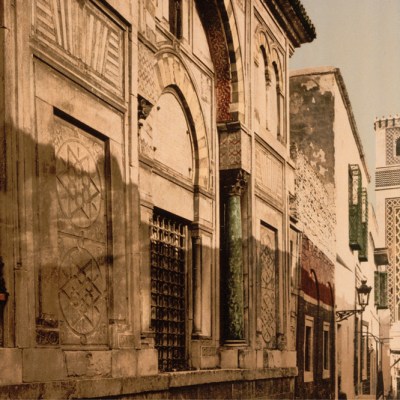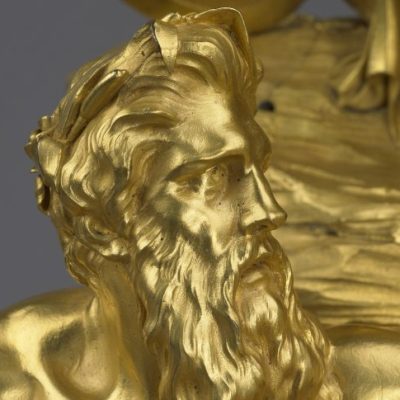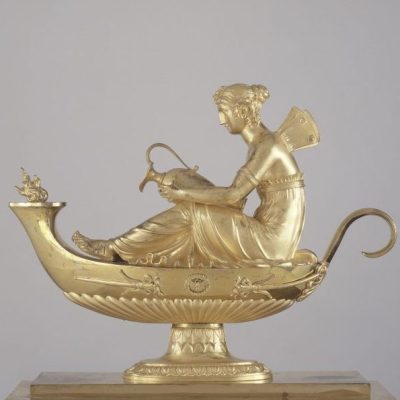If you are meeting someone in Tunisia’s capital, you may well propose to meet at the clock tower on the main thoroughfare. The 38m-high clock on the Avenue Habib Bourguiba in Tunis is nicknamed ‘Big Ben Ali’ by some because it was erected in 2001 by the dictator Zine El Abidine Ben Ali, whose 23 years in power were marked by the proliferation of clock monuments in Tunisia’s public spaces. On 14 January 2011, Ben Ali was forced to flee the country by the popular revolt that had begun the December before, the first in a series of uprisings across the region.
In the decade since the Tunisian Revolution, a young democracy has been established and essential liberties have been gained, yet over the last month, protests have escalated across the country. Part of the reason can be found in the survival of Ben Ali’s big clock, or rather what it represents.
Prior to the current clock, there was another in the same spot. And prior to that clock, there was a statue of Habib Bourguiba, the first president of the Tunisian republic. After independence, Bourguiba had removed a statue of Jules Ferry, the French minister who colonised Tunisia, and replaced it with one of himself on a horse. And so, when Ben Ali took power in 1987, he needed to remove Bourguiba from this politically symbolic place.
Ben Ali seized power in November 1987 in a bloodless coup. The statue of his predecessor was removed shortly after without fanfare and put aside in the seaside suburb of La Goulette. Other statues of Bourguiba disappeared or were also moved around; some were kept in storage.
Not all the statues were removed by the authorities. The brass Bourguiba-head on the Ain Salem roundabout in the coastal town of Gabès was pulled down during the 1984 bread revolts. ‘We had a football match with the head in ’84. He has no hair, he is like a ball,’ reminisces Sami Hassine, 50, the owner of a motorcycle repair shop located on the roundabout. The army was called to disperse the protesters and a tank accidentally ran over the head, he adds. Eight years later – and six years after Ben Ali took power – a clock was put in the same place.
A clock monument in the municipality of Ariana, north of Tunis, in October 2020. Photo: the author
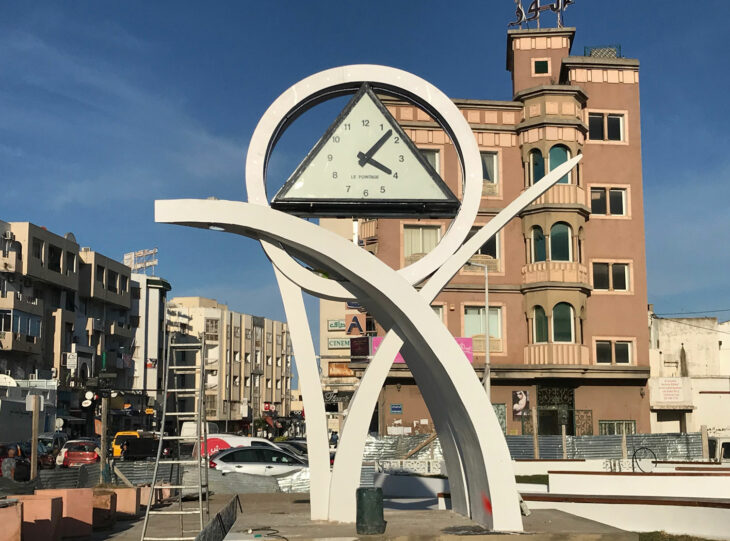
Ben Ali also loved the number seven, since he took power on 7 November. He had monuments in the shape of the number seven erected as well as seven-shaped clocks, several of which – including the forerunner of the current monument on Avenue Habib Bourguiba – had a seven to mark half past the hour instead of a six. ‘All the municipalities wanted the most beautiful seven and the most beautiful clock, it was a party [loyalty] thing,’ says Vincent Geisser, a French researcher who lived in Tunisia from 1995 to 2000. He says that Ben Ali used a ‘half-hearted strategy’ as he wanted to derive legitimacy from Bourguiba’s status as ‘father of the nation’, while also eliminating him. He didn’t remove Bourguiba’s name from the roads and squares; banknotes bearing Bourguiba’s likeness were not made void.
There doesn’t seem to have been a central clock committee. Rather, each locality received an instruction to erect a clock in whatever style they wanted, says Mokhtar Hammami, who worked in the department of local affairs at the time. ‘It was to tell people, “You need to respect the time,”’ he says. ‘I don’t know if there was something political behind it, I am apolitical, I am an administrator.’ It is perhaps the perfect comment for a monument and a politics that is saying absolutely nothing. Iheb Guermazi, an architectural historian, sees the prevalence of clock monuments across the country as a ‘manifestation of a whole era’ that goes far beyond Tunisia. He points to the Turkmen president’s recent statue of a golden dog as being in the same category. ‘It’s a post-ideological world and a post-political world. There is nothing to be declared. Solutions are given to you by banks and the IMF [as if politicians] are not really here,’ he says, adding that a clock may have been a symbol of progress and technology some 100 years earlier, when people didn’t have watches. A clock in 2001, however, is not amazing, it’s mute.
After the revolution of 2011, there were discussions about whether Ben Ali’s big clock should be removed from the main avenue. During one protest in 2012, Salafists climbed the clock tower and covered it with black flags. Drawing on the situationist idea of reclaiming public space through play, Nidhal Chamekh’s The Anti-Clock Project, imagined a contraption that could have been inspired by the game Mouse Trap. In this work presented at the Venice Biennale in 2015, the clock tower is destroyed by the big sphere atop the nearby Cité de la Culture building (another Ben Ali project). The latter rolls along a slide like a giant marble and crushes the clock. ‘It is a ball, like this memory of the snowball [uprising] that happened in Tunisia and destroyed a very vertical dictatorship,’ Chamekh says.
Ben Ali’s elected successor Moncef Marzouki secured funding from Microsoft and Facebook and one of his aides commissioned Guermazi and a French architect to reconceptualise the roundabout. Guermazi proposed removing the clock tower and redesigning the whole plaza from the bridge on one side to the Ministry of Interior on the other, so that it would become an open public space that prioritised pedestrians over cars. The Ministry of Interior – where most of the crimes of the dictatorship had been carried out or planned – had to stay where it was despite the wishes of Marzouki, who in reality had little power. ‘He was told no-one is touching that,’ Guermazi says.
Marzouki liked their idea, but nothing happened. Instead of providing an alternative, politicians looked to the past. In 2016, the clock was joined by the old statue of Bourguiba during the presidency of Beji Caid Essebsi, whose party, as did others, made an appeal to Bourguiba’s legacy to gain popularity. There was an outcry because of the amount of money that was spent on a statue at a time of economic crisis.
The statue of Tunisia’s first president, Habib Bourguiba, as it is moved back to its original location in Avenue Habib Bourguiba in Tunis after its removal from La Goulette, on the northern outskirts of the capital. Photo: Fethi Belaid/AFP via Getty Images
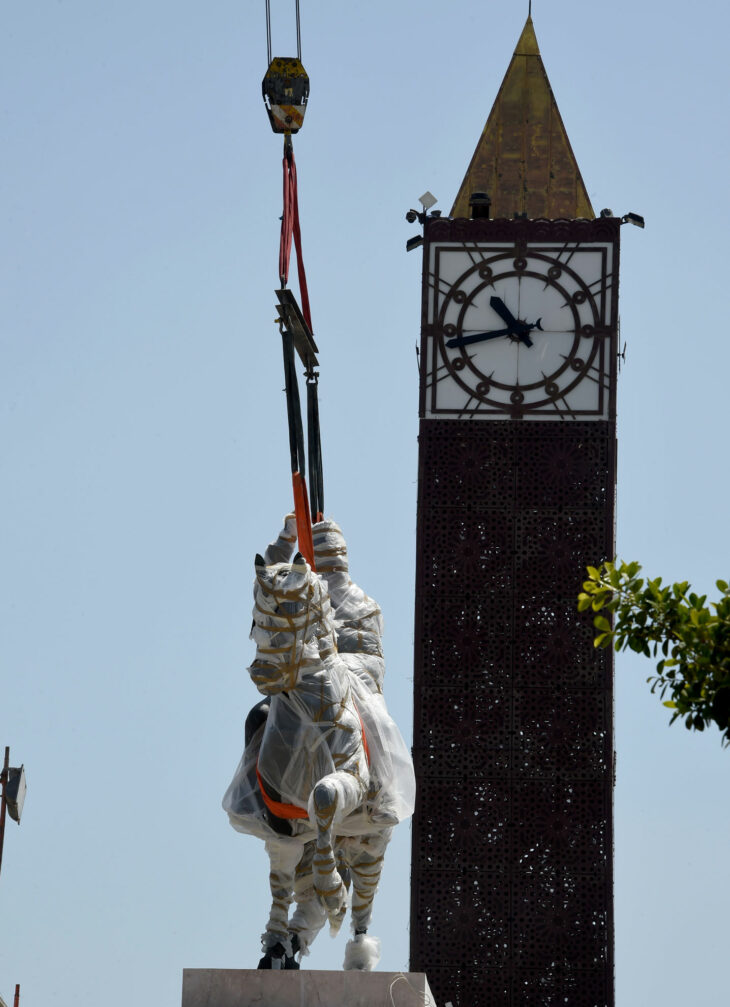
Today, the statue of Bourguiba stands facing away from Ben Ali’s clock, which is on a square renamed ‘14 January’ after the revolution ten years ago. ‘It is a cemetery,’ says Guermazi, who thinks that a post-revolutionary depression has set in due to the lack of a political project and audacity after 2011. ‘The most radical opponents to Ben Ali were saying “Let’s think about reforming taxes,’” he explains. ‘Man, it’s a revolution. Do you know that? Are you aware? Are you aware of the potential of change that you have in front of you right now with the collapse of a regime and with the whole population ready to go into another direction?’ For Guermazi, the lack of a political project to contain such revolutionary energy explains why so many Tunisians joined ISIS; it also explains why the clock is still around.
In October this year, the municipality of Ariana, north of Tunis, revamped a 30-year-old clock, which had originally been placed between a pair of sevens standing in a broken fountain. Fadhil Moussa, the mayor, told me at the time that they had removed the numerals, which glorify the old regime, but repaired the broken clock because ‘the place was known for being the place of the clock, and clocks are helpful’. I asked whether they had considered putting up something other than a clock. ‘Your question is confusing,’ he replied. ‘Could we put another sculptural work instead of a clock? What would we put if not a clock?’
